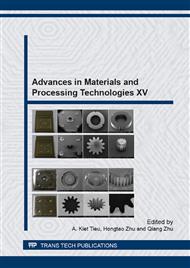p.803
p.812
p.818
p.827
p.833
p.842
p.851
p.865
p.880
Thermal Parameter Affects on the Part Built Using 3D Printer Projet SD 3000
Abstract:
The implementation of Rapid Prototyping technology in industrial and manufacturing processes has revolutionized new product development process. However, there are some restrictions of RP parts, primarily in the geometrical accuracy, shrinkage and distortion after the typical post processing method. This paper presents the experimental study using specially designed specimen to determine the effect of thermal parameter used on the RP part built using 3D printer ProJet SD 3000. The parameters of concern are geometrical dimension, shrinkage and flatness. The mechanical properties of the specimen have been determined using the tensile testing machine in order to indentify the effect of post processing temperature on the strength of the specimens. It is expected that the post processing temperature will play the major role in maintaining the geometrical accuracy of the RP products since heating used will lead to increase the shrinkage, warpage and reduce the accuracy. The effects of the heating used during post processing on the geometrical accuracy, shrinkage, strength and warpage on the specimens are discussed in this paper.
Info:
Periodical:
Pages:
833-841
Citation:
Online since:
November 2013
Keywords:
Price:
Сopyright:
© 2014 Trans Tech Publications Ltd. All Rights Reserved
Share:
Citation:


